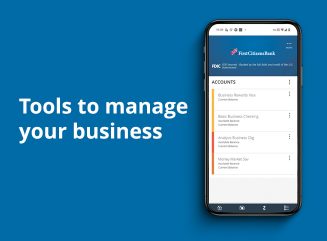
Digital banking for business
Seamlessly access all of your accounts from one place with First Citizens Digital Banking for business.

Control your portfolio
Invest how you want, when you want, in real time with Self-Directed Investing.

Digital banking for business
Seamlessly access all of your accounts from one place with First Citizens Digital Banking for business.
See how we're supporting companies
We're committed to serving companies as they expand and succeed. The proof is in our success stories.
Q4 Quarterly Market Review: Available now
The Making Sense team reviews changes in the market during Q4 2025.
The COVID-19 pandemic stressed many aspects of our economy, and pandemic hiring has since become one of the most pressing issues facing businesses of all sizes.

In 2021, the America Works Report by the US Chamber of Commerce showed there were only 1.4 workers available for every open job, which is half the historical average of 2.8 workers that's been steady for 20 years. As a business owner, you might consider adapting your hiring strategy or hire seasonal employees to keep your business running smoothly in lieu of future global health crisis events.
The post-pandemic hiring landscape isn't easy to navigate in such a tight labor market. In 2023, the US labor market expanded while unemployment kept higher rate averages. US industries such as education, healthcare and professional services are still struggling to compete for available workers.
There are ways you can better manage staffing challenges, implement strategies to add new talent and leverage what you already have. Here are a few things you can do, even with limited resources.
The pandemic's major upheaval of our society has one silver lining for individuals and businesses—it gave us all a chance to reassess what was working before. Employers and workers alike may not have believed that working from home was possible in so many industries, but the pandemic made it clear that working remotely has several benefits—including reduced costs.
When thinking about your hiring practices, start with a quick assessment of what you truly need compared with what you were accustomed to doing before the pandemic. If you've lost employees, do you need to backfill those positions or could you adjust your workflow and routines in a more sustainable way? Can you automate tasks to reduce staffing needs by adding a virtual assistant or online tool to schedule appointments?
Reevaluate your business's current needs to help you determine more creative methods for meeting those needs without necessarily increasing staff.
If you need to hire additional staff, expand your criteria to get a wider pool of candidates. If a prospect doesn't have the right experience but seems like a fast learner, they could learn on the job and fill an otherwise open position—and you'll be developing a new, trained team member in the process. Offering ongoing training by reskilling existing employees can also help close the skills gap.
When creating job postings, make sure each post accurately reflects the role, responsibilities and business culture. Also be transparent about the perks of working at a small business, whether it's a stronger sense of teamwork, flexible work schedules or free meals.
If it's within your budget, consider offering a sign-on bonus to new hires. Upfront cash can motivate prospects to sign a contract faster, and using existing employees as resources can help increase your chances of hiring and onboarding excellent workers. They know your small business and can be your best recruiters. If they find a candidate you hire, offer them a referral bonus.
When you find the ideal candidate, make an offer as soon as possible. Don't delay, or you could lose that candidate to a competitor.
A great way to attract and retain talent is to offer benefits that employees truly need, rather than what you assume they might need. Use employee engagement strategies to positively impact retention rates, and talk with existing workers to learn what they like about working for you and what they might want to change.
Other ways to boost morale that may appeal to existing and new hires include creating an open-door policy, facilitating a more inclusive environment, incorporating more flexible schedules and adding small perks like free snacks.
Think about what else you can do to meet your employees' needs. Can you offer unique job perks, flexible scheduling, special training or employee referral bonuses? Can you increase their compensation? While the cost of raising pay may seem high, it's still lower than the financial and time-related costs of consistent turnover.
If you can't afford to increase pay, consider offering profit sharing, expanded health insurance, performance bonuses, gym memberships, expanded paid time off or a hybrid working environment.
While post-pandemic hiring may be the new normal for small businesses recruiting new talent, adjusting strategically can open your business to greater resources and new streams of talent. By determining your current business needs and asking employees about their own needs, you can find a cost-effective way to attract and retain the talent necessary to keep your business thriving.



This material is for informational purposes only and is not intended to be an offer, specific investment strategy, recommendation or solicitation to purchase or sell any security or insurance product, and should not be construed as legal, tax or accounting advice. Please consult with your legal or tax advisor regarding the particular facts and circumstances of your situation prior to making any financial decision. While we believe that the information presented is from reliable sources, we do not represent, warrant or guarantee that it is accurate or complete.
Third parties mentioned are not affiliated with First-Citizens Bank & Trust Company.
Links to third-party websites may have a privacy policy different from First Citizens Bank and may provide less security than this website. First Citizens Bank and its affiliates are not responsible for the products, services and content on any third-party website.
First Citizens Bank & Trust Company is a Member FDIC and an Equal Housing Lender icon: sys-ehl.
NMLSR ID 503941

Treasury & Cash Management
Electronic Bill Presentment & Payment
Investment & Retirement Services
Community Association Banking
Equipment Financing & Leasing
Credit Cards
Merchant Services
Email Us
Please select the option that best matches your needs.
Customers with account-related questions who aren't enrolled in Digital Banking or who would prefer to talk with someone can call us directly.